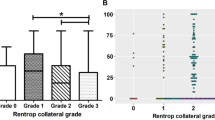Summary
Using myocardial contrast echocardiography (MCE), coronary arteriography, and thallium-201 myocardial imaging (TMI), we examined the characteristics and the role of collateral vessels in 35 patients with coronary artery lesions after Kawasaki disease. The male/female ratio was 25∶10. The patients' ages at examination ranged from 1.0 to 20.3 years (mean, 10.8 years). The age at onset of Kawasaki disease ranged from 0.3 to 11.6 years (mean, 2.6 years). The coronary artery lesions were: dilated lesions without coexistent stenotic lesions in 5 patients (14%), localized stenosis with less than 50% narrowing in 5 patients (14%), localized stenosis with 50% or more narrowing in 4 patients (11%), and obstructive lesions, such as occlusion and/or segmental stenosis, in 21 patients (60%). In the group with no stenotic lesions and the group with less than 50% localized stenosis, the perfusion area of the right coronary artery was 32.6±8.4% and that of the left coronary artery was 76.3±7.9%. The total perfusion area of the right and the left coronary arteries was 108.9±2.6%, which value was inversely correlated with age at examination (r=0.716,P=0.020). In the group with more than 50% localized stenosis, an increase in overlap areas detected by MCE, where a perfusion defect was seen on TMI, was not found, except in 1 patient with 99% stenosis. In the patients with obstructive lesions, development of collateral channels was better in the perfusion area of the occluded right coronary artery than in that of the occluded left coronary artery, and well developed collateral channels were significantly correlated with good wall motion. We conclude that overlapping perfusion occurs in younger rather than in older children without stenotic coronary systems and this may contribute to the good development of collateral circulation in infants and young children with coronary artery lesions after Kawasaki disease.
Similar content being viewed by others
References
Nakano H, Ueda K, Saito A, Nojima K (1985) Repeated quantitative angiograms in coronary artery aneurysm in Kawasaki disease. Am J Cardiol 56:846–851
Yanagisawa M, Kobayashi N, Matsuya S (1974) Myocardial infarction due to coronary thromboarteritis following acute febrile mucocutaneous lymph node syndrome in an infant. Pediatrics 54:277–281.
Radford DJ, Sondheimer HM, Williams GJ, Fowler RS (1976) Mucocutaneous lymph node syndrome with coronary artery aneurysm. Am J Dis Child 130:596–598
Kegel SM, Dorsey TJ, Rowen M, Taylor WF (1977) Cardiac death in mucocutaneous lymph node syndrome. Am J Cardiol 40:282–286
Kato H, Ichinose E, Kawasaki T (1986) Myocardial infarction in Kawasaki disease: Clinical analyses in 195 cases. J Pediatr 108:923–927
Onouchi Z, Hamaoka K, Kamiya Y, Hayashi S, Ohmochi Y, Sakata K, Shiraishi I, Hayano T, Hukumochi H (1993) Transformation of coronary aneurysm to obstructive lesion and the role of collateral vessels in myocardial perfusion in patients with Kawasaki disease. J Am Coll Cardiol 21:158–162
Gensini GG, Bruto da Costa BC (1969) The coronary collateral circulation in living man. Am J Cardiol 24:393–400
Sabia PJ, Powers ER, Ragosta M, Sarembock IJ, Burwell LR, Kaul S (1992) An association between collateral blood flow and myocardial viability in patients with recent myocardial infarction. N Engl J Med 327:1825–1831
Feinstein SB, Lang RM, Dick C, Neumann A, Al-Sadil J, Chua KG, Carroll J, Feldman T, Borow KM (1988) Contrast echocardiography during coronary arteriography in humans: Perfusion and anatomic studies. J Am Coll Cardiol 11:59–65
Cheirif J, Zoghbi WA, Raizner AE, Minor ST, Winters WL, Klein MS, De Bauche TL, Lewis JM, Roberts R, Quinones MA (1988) Assessment of myocardial perfusion in humans by contrast echocardiography. I. Evaluation of regional coronary reserve by peak contrast intensity. J Am Coll Cardiol 11:735–473
Keller MW, Glasheen W, Smucker ML, Burwell LR, Watson DD, Kaul S (1988) Myocardial contrast echocardiography in humans. II. Assessment of coronary blood flow reserve. J Am Coll Cardiol 12:925–934
Grill HP, Brinkner JA, Taube JC, Walford GD, Midei MG, Flaherty JT, Weiss JL (1990) Contrast echocardiographic mapping of collateralized myocardium in humans before and after coronary angioplasty. J Am Coll Cardiol 16:1594–1600
Lin YJ, Nanto S, Masuyama T, Kodama K, Koyama A, Kitabatake A, Kamada T (1990) Coronary collateral assessed with myocardial contrast echocardiography in healed myocardial infarction. Am J Cardiol 66:556–561
Kamiya T, Kawasaki T, Okuni M, Kato H, Baba K, Nakano H (1984) Report of subcommittee on standardization of diagnostic criteria and reporting of coronary artery lesions in Kawasaki disease. Research Committee on Kawasaki disease, Ministry of Health and Walfare press, Tokyo, pp 1–10.
Suzuki A, Kamiya T, Ono Y, Kinoshita Y, Kawamura S, Kimura K (1993) Clinical significance of morphologic classifiction of coronary arterial segmental stenosis due to Kawasaki disease. Am J Coll Cardiol 71:116–1173.
Kinoshita Y, Suzuki A, Nakajima T, Ono Y, Arakaki Y, Kamiya T (1994) Myocardial contrast echocardiography of coronary artery lesions due to Kawasaki disease. Heart Vessels 9:254–262
Lim YJ, Nanto S, Masuyama T, Kodama K, Ikeda T, Kitabatake A, Kamada T (1989) Visualization of subendocardial myocardial ischemia with myocardial contrast echocardiography in humans. Circulation 79:233–244
Rogosta M, Camarano G, Kaul S, Poweres ER, Sarembock IJ, Gimple LW (1994) Microvascular integrity indicates myocellular viability in patients with recent myocardial infarction: New insights using myocardial contrast echocardiography. Circulation 89:2562–2569
Touchstone DA, Beller GA, Nygaard TW, Tedesco C, Kaul S (1989) Effects of successful intravenous reperfusion therapy on regional myocardial function and geometry in humans: A tomographic assessment using two-dimensional echocardiography. J Am Coll Cardiol 13:1506–1513
Hansen JF (1989) Coronary collateral circulation: Clinical significance and influence on survival in patients with coronary artery occlusion. Am Heart J 117:290–295
Tatara K, Kusakawa S, Itoh K, Honma S, Hashimoto K, Kazuma N, Lee K, Asai T, Murata M (1991) Collateral circulation in Kawasaki disease with coronary occlusion or severe stenosis. Am heart J 121:797–802
Author information
Authors and Affiliations
Rights and permissions
About this article
Cite this article
Kinoshita, Y., Suzuki, A., Nakajima, T. et al. Collateral vessels assessed by myocardial contrast echocardiography in patients with coronary artery lesions after Kawasaki disease. Heart Vessels 11, 203–210 (1996). https://doi.org/10.1007/BF02559993
Received:
Revised:
Accepted:
Issue Date:
DOI: https://doi.org/10.1007/BF02559993




